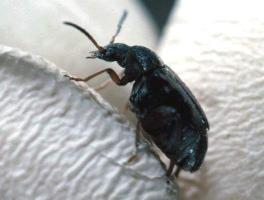Introduction
The main storage pests, apart from rodents, are beetles and moths.
Some pests such as grain borers, weevils and Angoumois grain moths are able to feed on whole, healthy grains, they are considered primary pests. Secondary pests such as flour beetles can attack only broken grain, moist and thus soft grain, grain damaged by primary pests or processed products such as flour.
Contamination by fungi also causes direct losses and poses a threat to human and animal health by producing poisons known as mycotoxins, which contaminate food and feed.
Beetles: Weevils, Grain Borers, Bruchids, Khapra Beetles
The main beetle pests of storage are bruchids (e.g. cowpea seed beetles and bean bruchid), grain borers (e.g. the larger and the lesser grain borers), weevils (e.g. grain weevils), flour beetles, Khapra beetles and dried fruit beetles.
The larvae and some adult beetles feed in the seeds and grain, leaving them full of small holes. Sometimes a fine dust is found around the holes, being the excrements of these beetles. Beetle damage renders grains and seeds unsuitable for human and, in case of heavy attack, even for animal consumption.
Cowpea bruchids (Callosobruchus spp.)
|
|
Cowpea bruchids (Callosobruchus spp.) are the most common and widespread insect pests in storage. Adults are 2 to 3.5 mm long. They are major pests of pulses (cowpeas, pigeon peas, soybean, geen gram and lentils). They attack both pods in the field and seeds in storage. They attack nearly mature and dried pods. Infested stored seeds can be recognised by the round exit holes and the white eggs on the seed surface. Post-harvest losses are highly variable, but losses can be over 90%.
What to do:
Pods should be harvested as soon as they mature and the seeds sun dried before stored in clean beetle-proof containers. A coating of edible oils or of inert clay can prevent further development of bruchids in the stored seeds. Some farmers in East Africa use wood ash in grain stored for food or seed for planting, or chillies or smoke from cooking fire to preserve seeds for planting. Other farmers store unthreshed pods as a strategy to minimise grain damage by bruchids (Minja et al. 1999). |
||||
|
Cowpea seed beetle (Callosobruchus maculatus). Adult female on cowpea (Vigna unguiculata) seeds.
Ⓒ Peter Credland. Reproduced from the Crop Protection Compendium, 2006 Edition. CAB International, Wallingford
|
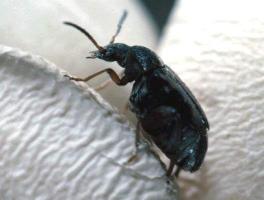 |
||||
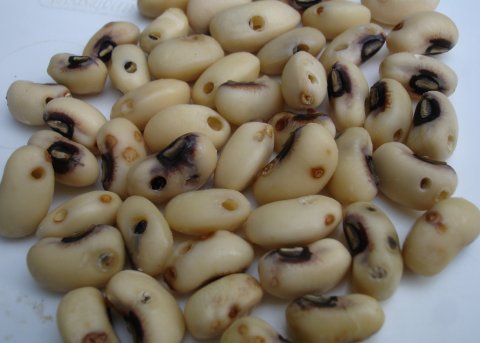 |
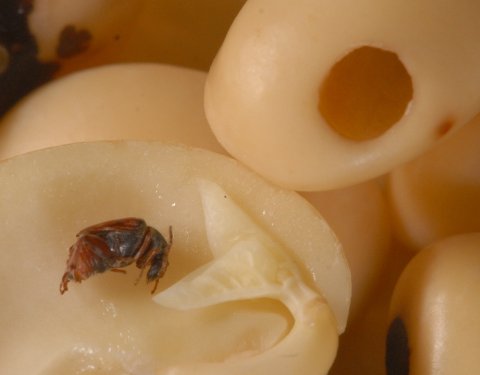 |
||||
|
|
|
||||
|
|
For more information on cowpea pests click here
For more information on cowpea seed beetle click here
Bean bruchid (Acanthoscelides obtectus)
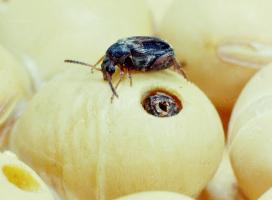 |
This beetle, also known as the dry bean weevil, is about 3 to 5 mm long, oval in shape, grey and reddish brown with yellowish and dark patches of hairs on the wing cases. The wing cases are short and do not cover completely the abdomen.
This beetle is a major pest of beans. Attack by this beetle often starts in the field. Female beetles lay eggs on the ripening pods on the crop or among stored beans. The larvae bore the way into the seed and feed inside. The presence of mature larvae or pupae can be recognised by the small circular windows on the bean seeds. The life cycle is completed inside the seed and the adult beetle emerges by pushing the window, which falls off leaving a neat round hole about 2 mm in diameter. What to do:
Intercropping maize with cowpeas, and not harvesting crops late significantly reduced infestation by the bean bruchid (Acanthoscelides obtectus) and cowpea bruchids in Kenya (Olubayo and Port, 1997). |
| Bean bruchid (Acanthoscelides obtectus) on soybean | |
|
Ⓒ Clemson University - USDA Cooperative Extension Slide Series, (www.bugwood.org)
|
Larger grain borer (Prostephanus truncatus)
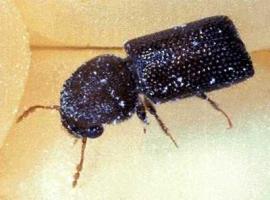 |
The larger grain borer is a serious pest of stored maize and dried cassava roots, and will attack maize on the cob, both before and after harvest. What to do: |
|
| Larger grain borer (Prostephanus truncatus). The adult beetle is 3 to 4.5 mm long. | ||
|
Ⓒ NRI/MAFF. Reproduced from the Crop Protection Compendium, 2004 Edition. ⒸCAB International, Wallingford.
|
For more information refer to datasheet on the larger grain borer (click here)
Lesser grain borer (Rhizopertha dominica)
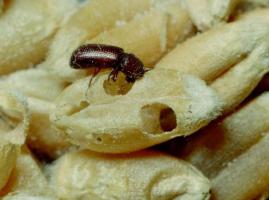 |
This is a tiny beetle (2-3 mm long) with a slim and cylindrical shape and red-brown to black in colour. The thorax bears rows of teeth on its upper front edge and the head is turned down underneath the thorax so that it cannot be seen from above. Eggs are laid loose among the cereal grains. The larvae are mobile. Both larvae and adult bore through the stored produce usually causing characteristic round tunnels (up to 1 mm diameter). In later stages of infestation these beetles may also hollow out the grains. Pupation usually takes place within the eaten grain. The lesser grain borer is primarily a pest of cereal grains, other seeds, cereal products and dried cassava. It will be controlled by any method that controls the larger grain borer. |
| Lesser grain borer (Rhyzopertha dominica). Adults are 2 to 3 mm in length and reddish-brown in colour (shown on wheat grains). | |
|
Ⓒ Clemson University - USDA Cooperative Extension Slide Series, United States, (www.bugwood.org)
|
For more information refer also to datasheet on the larger grain borer (click here)
Grain weevils (Sitophilus spp.)
 |
The adults are small (2.5 to 4.0 mm long), brown weevils with a long, narrow snout. Female lays eggs inside the grain. The larva (grub) lives and feeds inside the grain hollowing it out. The adult attacks whole or damaged grains causing irregularly shaped holes. Grain weevils attack grains either in the field before harvest or in the store. The rice weevil (Sitophilus oryzae) is a major pest of rice, maize and other cereals in store. |
| Rice weevil (Sitophilus oryzae) | |
|
Ⓒ Courtesy EcoPort (http://www.ecoport.org): Food Agency and Ministry of agriculture, forestry
|
Flour beetles (Tribolium castaneum, T. confusum)
The adults are elongated beetles, 3 to 4 mm long, red brown to dark brown in colour. The wing cases are marked with finely punctured lines. Larvae and adults are secondary pests and attack cereals and cereals products, groundnuts, nuts, spices, coffee, cocoa, dried fruits and occasionally pulses. Infestation leads to persistent unpleasant odours of the products.
Khapra beetle (Trogoderma granarium)
The adults are oval beetles, 2 to 3 mm long, dark brown in colour often with blurry reddish markings. The larvae are very hairy. They are common in hot dry areas. Damage is done only by larvae feeding on cereal grains and products, groundnuts, oilseed cakes, nuts, pulses, etc.
Dried fruit beetles(Carpophilus spp.)
They are slightly flattened ovate to oblong beetles, 2 to 5 mm in length. The wing cases are short, leaving part of the abdomen exposed. They are light brown to black in colour, but several species have yellow or red markings on the wing cases. They are secondary pests; presence of these beetles is an indicator of damp, mouldy conditions. Adults and larvae cause damage on poorly dried cereal grains, cocoa, copra, oilseeds, dried fruit, vegetables, herbs and mouldy produce.
Moths
The potato tuber moth (Phthorimaea operculella)
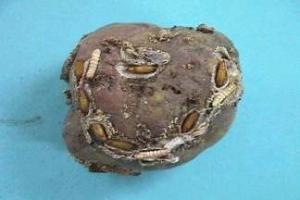 |
| Pupae of the potato tuber moth on potato tuber. |
|
Ⓒ J. Kroschel, CIP
|
This moth is the most serious pest of potatoes in the region. It occurs in Africa wherever potatoes are grown, and it also attacks tobacco, eggplants and tomatoes.
Caterpillars of the potato tuber moth are up to 12 mm long and feed as leaf miners, causing silver blotches on leaves, and bore into the petiole or a young shoot or main leaf vein and later into the tuber. This causes wilting of plants. When eggs are laid on tubers, caterpillars begin feeding on the tubers immediately upon hatching making long irregular black tunnels, which are filled with excreta (faeces), where disease-causing microorganisms grow.
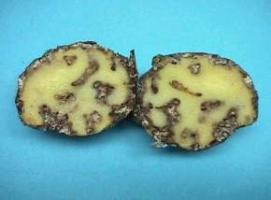 |
| Potato tubers damaged by the potato tuber moth. |
|
Ⓒ J. Kroschel, CIP
|
Major damage is caused by caterpillars burrowing in the tubers. Infestations start in the field. The pest is transferred with the harvested tubers to the potato store, where it can reproduce and infest other tubers. This may lead to total destruction of the stored crop.
 |
| Parasitic wasp (Copidosoma khoeleri), a natural enemy of potato tuber moth. |
|
Ⓒ J. Kroschel, CIP
|
Natural enemies are important for natural control of the potato tuber moth. However, in many cases control by local natural enemies is not satisfactory. Therefore, several parasitic wasps, native from South America, the area of origin of the pest, have been introduced to several countries in Africa. These wasps have provided effective control of the pests in several countries in Southern and Eastern Africa.
Cultural methods (e.g. ridging, use of healthy seed tubers) and biopesticides (e.g. Bt, neem, lantana) as described below are also important for managing this pest.
What to do:
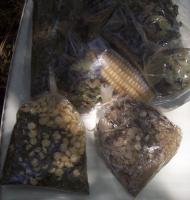 |
| Lantana leaves protect maize and cowpeas from storage pests |
|
Ⓒ Anne Bruntse, Biovision
|
- Farmer experience: Meru Ministry of Agriculture Field Officer Mr Mwai (2007) had tested mixing dried lantana leaves with stored maize and beans - his samples had stayed for over a year without getting attacked by storage pests.
- Use healthy, clean seed, since infested seed tubers are the main cause of re-infestation in the field.
- Avoid planting in rough soil. Plant as deeply as possible (10 cm deep) and ridge at least 3 times during the growing season. Experiments in Sudan showed that increasing the sowing depth from 2.5 cm practiced by farmers to 7.6 cm, significantly reduced damage by the cutworms and the potato tuber moth and resulted in an increase of 3.7 t/ha in marketable yield (Siddig, 1987).
- Compact hilling is very important to prevent moths reaching the tubers to lay eggs. For caterpillars it would also be difficult to reach the tubers, and emerging moths from infested tubers will be killed, since they are not able to penetrate so deep into the soil.
- Provide enough water to prevent soil cracks.
- Mulch the plants with rice straw and/or with leaves. Mulching with neem leaves during the last 4 weeks before harvest significantly reduced insect damage in Sudan (Ali, 1993).
- Intercrop potatoes with hot pepper, onions or peas.
- Harvest the crop immediately as it matures, as tubers left in fields for longer periods are highly infested.
- At harvesting, ensure that the tubers are not exposed to moths before they are properly protected in the store. All harvested tubers have to be bagged and removed before late afternoon every day.
- Destroy all infested potatoes immediately and remove all plant residues from the field. Caterpillars pupate in the tubers and dry stems left in the field.
- Destroy all volunteer potato plants before planting new potato crops.
- Use alternative pesticides to protect potatoes in store. Neem can be applied to reduce damage by the potato tuber moth. For instance, in India a four months protection was achieved when harvested potatoes and the covering material was sprayed with 5 and 10% enriched neem seed extract (Saxena, 1995). In Sudan spraying neem seed and leaf extracts (1 kg/40 l water) and then placing tubers in jute sacks reduced post harvest losses by the potato tuber moth compared with traditional methods such as leaving the tuber unprotected or covering them with banana leaves only (Siddig, 1987). Salem (1991) showed that a neem seed extract was effective for control of the potato tuber moth on potatoes in a store in Egypt. Storage loss after 6 months in potatoes treated with 100ppm neem oil was 25% (compared to 10% with the insecticide carbaryl). Adults from larvae treated with neem oil were deformed. Work in Yemen confirmed the beneficial effect of neem. Neem oil and sunflower oil halted the development of caterpillars of the potato tuber moth in storage. However, caution is needed since the oil seemed to interfere with potato respiration, leaving the potatoes very soft with dark tissue (Kroschel, 1995).
- A Bt (Bacillus thuringiensis) preparation in powder form mixed with fine sand (1:25) dusted was very effective in controlling this pest in the store in Yemen and Kenya (Kroschel, 1995) Tuber infestation was also reduced by bedding the potatoes in the leaves of the Peruvian pepper tree (Schinus molle), also known as mpilipili in Swahili, and Eucalyptus sp. (Kroschel, 1995).
- Where this pest is present potatoes should be stored in layers with branches of lantana (Kenya Institute Organic Farming), which repels tuber moth but does not actually kill it. Also application of plenty of wood ash or diatomite earth may prevent rapid build up of tuber moth
For more information about the potato tuber moth click here
Grain moths
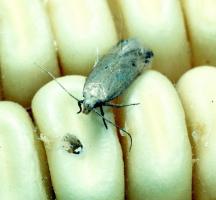 |
| Angumois grain moth on maize. The moth is small, pale brown, 5-7 mm long with wings folded, wingspan 1-1.6 cm |
|
Ⓒ Clemson University- www.insectimages.org
|
Angoumois grain moth (Sitotroga cerealella)
The moths of the Angoumois grain moth are small (about 1 cm long with a wing span of 10 to 18 mm), yellowish or straw-coloured, and have a fringe along the posterior margins of the wings. They can be observed flying around infested stores.
Female moths lay ovoid and pinkish eggs at night in clumps on the outside of cereal grains, in cracks, grooves or holes made by other insects. Eggs are initially white turning red near hatching. The larvae are caterpillars of dirty white colour and about 8 mm long when fully grown. Caterpillars penetrate into and feed inside whole grains. They prepare a round exit hole for the moth, leaving the outer seed wall only partially cut as a flap over the hole, resembling a trap door.
The adult pushes its way out through this "window" leaving the trap door hinged to the grain. Infested grains can be recognised by the presence of these small windows. The adult lifespan may be up to 15 days, and one female can lay over 100 eggs.
They are pests of whole cereal grains like paddy, sorghum, maize and wheat. Damage is similar to that caused by weevils. This moth may also infest the crop in the field prior to harvest, and damage can reach serious levels, before the grains are stored.
 |
| Storage moth (Ephestia cautella). |
|
ⒸCourtesy EcoPort (http://www.ecoport.org): Ministry of agriculture, Japan
|
Storage moths or tropical warehouse moth (Ephestia cautella, Corcyra cephalonica, Plodia interpunctella)
The main storage moths are the tropical warehouse moth (Ephestia cautella), the rice moth(Corcyra cephalonica), and the Indian meal moth (Plodia interpunctella). These storage moths are small (15 to 20 mm wingspan), greyish brown in colour with an indistinct pattern.
The moth of the Indian meal moth is distinctive with the outer half of the forewings a coppery-red separate from the creamy inner half by dark grey bands.
Female moths lay eggs through holes in the bags. Larvae are elongated whitish caterpillars about 2 cm long. They feed on the seed germ, moving about freely in the stored foodstuff. They cause extensive damage in cereal flowers and other milled products, but also in whole grains, mainly feeding on the germ. They also attack nuts, groundnuts, dry fruit, cocoa, copra and other foodstuff.
The dense white cocoons of the pupae are often seen attached to the bag surfaces. Infestations are characterised by aggregations of kernels, frass, cocoon and dirt caused by webbing, which contaminates the foodstuff reducing its quality.
Fungi
Storage fungi require a relative humidity of at least 65%, which is equivalent to equilibrium moisture content of 13% in cereal grain. Storage fungi grow at temperatures of between 10°C to 40°C. Infection with certain species of fungi may already occur in the field, reducing considerably the storage life of grains.
- Loss of nutrients.
- Discolouration of the grain.
- Reduction of germination capacity.
- Caking of grains.
- Increase in the temperature of the stored goods up to spontaneous combustion.
- Mouldy smell and taste.
- Production of mycotoxins. These are toxic substances produced by various fungi under certain conditions, which remain in the stored product as residues. They are highly poisonous to both human and animals. The best-known mycotoxins are aflatoxin, ochratoxin, patulin and citrin. Aflatoxins, which are produced by Aspergilum flavus are regarded as very dangerous substance causing liver cancer.
Damage caused by fungi is often neglected until it has reached an advanced stage. However, it is very important to prevent growth of fungi, since it is the only way of avoiding mycotoxins. Mycotoxins are very stable and cannot be destroyed by boiling, pressing and processing. This means that infected produce has to be destroyed. Mycotoxins can be found in the stored product as soon as 24 hours after infection with fungus.
To prevent contamination by fungi, the produce must be properly dried, and any source of moisture in the store should be avoided.
Storing Seeds and Grains - Principles of Preventive Storage Protection
1. Choice of variety and selection of healthy seeds
Select the most suitable seeds for planting. Indigenous seeds have been developed for hundreds of generations and are well adapted to the areas where they are grown, whereas some modern varieties are higher yielding but may be more susceptible to pests. There is a widespread perception that modern, high-yielding varieties of maize may be more susceptible to storage pests. These varieties often have open cob husks, allowing insects and birds to easily attack maize in the field, whereas some of the traditional varieties have closed husks, thus effectively protecting the crop from insect attack. The same have been observed with some sorghum varieties. Therefore, the increased yield offered by some varieties should be weighed against the susceptibility to storage pests, the expected period of storage and the price to be expected for grain of a particular damage level. Efforts are going on to develop high yielding varieties with resistance to storage pests
Select the best seeds for next years planting avoiding damaged and sick looking seeds.
2. Choosing harvest time
If planting and harvesting is planned so that harvest falls in the dry season, there are no special problems with drying the crop. Care should be taken when cultivating new high yielding and early ripening varieties, since the harvest may fall in the wetter part of the year, and this may create problems of storage.
Some storage pests (e.g. bean beetles, cowpea bruchids, the larger grain borer and some moths) infest beans and grains in the field only when the crop is almost dry. Timely harvest can therefore ensure that these pests are not carried into the store along with the beans or grain. Thus, timely harvesting (avoiding late harvesting) significantly reduced infestation by the bean bruchid and cowpea bruchids in Kenya (Olubayo and Port, 1997). As a rule, do not leave crops in the field when they are ready for harvest, this increases the chances of infestation by some storage pests
3. Drying
Drying is an important procedure in storage protection. It prevents seed form germinating and prevents attack by fungi. Some fungi can cause cracking of seed thereby making the seeds more susceptible to pest attack. All seed must be dried to 12-13 % moisture in order to be stored safely. To make sure the seed is properly dried put one seed or kernel in the mouth and chew. If it cannot easily be cracked it is dry enough - if it crushes between the teeth it is not dry enough. This is known as the tooth test. See also salt test in 'The Organic Farmer Magazine' No. 30. November 2007.
Heat used for drying the produce will also kill larvae and chase away adults of insect storage pests. Care should be taken to avoid overheating since excessive heat can damage seed or grains. Care should be taken not to exceed the following temperatures: beans: 35 °C - seeds: 43 °C - cereals: 60 °C.
The following methods of drying are possible:
- Seed can be spread out in the sun on a hard clean surface to dry for several days in dry weather, until a seed cannot be bitten into when putting it in the mouth. The thickness of the layers of cobs, panicles, pods or grains must not exceed 5 cm, and the seed must be turned regularly in order to ensure good and even aeration. In the evening, the produce must be put in a pile and covered.
- Simple driers. Several designs of solar driers are available.
4. Sorting and cleaning the produce
Check whether the produce is infested by taking samples. Pay particular attention to cracks and gaps where insects may hide. If the produce is infested, ensure it is stored separately (quarantine) and treated in order to prevent the pests infesting clean produce. In case of heavy infestation discard the produce. In case the produce is slightly attacked, heating to no more than 50°C can kill moths and weevils; use a thermometer, as heating to any higher temperature will destroy the germination capacity the seeds See also heat treatment for seeds click here.
Removal of infested grains or cobs and pests can also be done by hand, sieving, winnowing or moving the grain (shaking, restacking). When using methods that merely separate the pests from the stored product, ensure that the pests removed from the produce are killed to avoid reinfestation.
5. Store location
Site stores away from any potential source of infestation. The grain and tuber moths are good flyers and adults from infested stores often infest growing crops in the field. Separations of stores from fields may help to reduce attack.
6. Characteristic of store
A good seed store must be airy, shady, cool and dry. Temperature variations should be as small as possible, because it encourages condensation of water, which promotes fungal development.
Crops in the store should be protected against dampness rising from the ground, and the site should be safe from flooding in the rainy season. The roof should have no leaks. Keep the temperature and humidity as low as possible (perform controlled ventilation). There are indications that storing grain in a dry place may help reduce infestation of grain moths.
Prevent pest entry by sealing the store (windows, doors, ventilation facilities) with insect-proof gauze. In Malawi, plastering stores with mud to reduce water uptake was found to be effective (Golob and Muwalo, 1984).
Hermetic, airtight storage at low humidity gives good protection against storage pests. However, to avoid mould growth care should be taken to ensure that the produce is dry. This is particularly applicable for long-term storage in warm dry areas. It is advisable however, not to store seed grain for more than a few months. In conditions where the relative humidity is high, airtight storage is not recommended due to the risk of mould growth.
Hermetic storage is useful for storing small amount of seeds or grains (e.g. to be used for replanting); they can be stored in a strong airtight container with a close fitting lid (glass, ceramic, strong plastic can be useful). Ceramic pots that do not have lids must be covered very carefully or topped up with dry soot, ashes or fine dry soil.
7. Storage hygiene
Always keep the store and its surroundings clean. It has been said: "the most important, economic and effective tool for storage hygiene is the broom". Before newly harvested crops are stored, the store should be carefully prepared well ahead of time. Old stored products should be removed and the room completely cleaned up. The whole building should be well aired and if possible fumigated or disinfected (see store fumigation and disinfection below). The walls roof and floor should be both watertight and rat proof, and small holes and cracks, which are potential breeding places for storage insects, should be sealed.
8. Inspecting the store
Periodic inspection (weekly to fortnightly) and removal of any infested produce is essential. Check for droppings and footprints of birds and rodents. Look for flying moths at dusk. Brush stacks of bags with a stick or broom to disturb and discover resting moths. Lift bags in order to detect moth cocoons along the line where bags touch each other.
When looking for beetles, pay particular attention to cracks, bag seams and ears where they often hide. Empty individual bags in a thin layer onto a sheet and examine the contents for beetles and larvae. This should be done in the shade so that the insects do not flee immediately.
Insects can be also be sieved out using a box sieve with a mesh of 1 to 2 mm. Identify the insect found in order to perform the correct treatment. These measures should prevent the breeding of carry-over insects from former crops. The surroundings should also be cleared to discourage easy re-infestation by insects and rodents.
Infection with fungi can be detected by the mouldy smell, which is noticeable even before any visual changes to the product can be seen. Pay attention to water marks on bags, which can be still noticed after the bags have dried.
9. Store fumigation
Farmers in the Philippines as well as in Benin lit fires in which powdered chilli pepper is burnt underneath grain stores once a month to keep away storage pests. One disadvantage is that the smoke is very sharp and uncomfortable for human eyes and respiratory system.
10. Store disinfection
After the store has been cleaned completely and all old deposits of dust (possibly containing insect eggs) has been removed, it is good practice to dust the whole store with diatomite earth, lime or ashes as a further prevention of problems. Where larger grain borer has attacked the wood in the construction, the wood should be treated with any of the approved wood preservatives or thoroughly sprayed with kerosene, oil mixture to get rid of any surviving grain borers.
Modernised granary
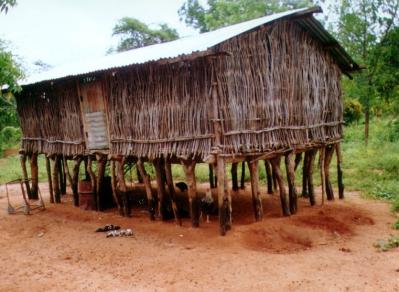 |
| Raised modernised granary with a high iron sheet roof with old oil smeared on the lower side of the support poles to prevent termite attack. |
|
Ⓒ J. Maundu, icipe
|
Traditional granary
 |
| Raised traditional granary with several layers of thick grass and old oil smeared on the lower part of support poles to prevent termite attack. |
|
Ⓒ J. Maundu, icipe
|
Additives are useful to protect stored produce from pest attack
Introduction
The use of mineral substances such as fine sand, clay dust, lime and wood ash cause invisible injuries to the stored food pest leading to dehydration. They also fill the spaces between the grains, making difficult for the pest movement and respiration. When using mineral substances the amounts required are around 50 to 100 g per kg of stored product, except for sand, of which larger amounts are required.
The addition of ashes, fine sand, lime, diatomite earth, and mineral or vegetable oils is particularly useful for protecting small farm seed storage, or for storing small amounts for replanting. However, this is not always practical for large quantities of seed in terms of labour required. For larger amounts of grains and seeds it is often more practical to simply mix the seed with any strong smelling plant material available to repel insects. Some plants such as pyrethrum and derris can actually kill storage insects.
Wood ash
Wood ash either alone or mixed with powdered chilli pepper is an efficient method of pest control. However, ashes may have an effect on the taste of the treated product. The success of this method depends on the amount of ashes being added. Ashes at 2 to 4 % by weight of grain is said to give 4 to 6 months protection if the moisture content of the grain is below 11%. Ashes from casuarinas, derris, mango and tamarind are particularly suitable. Any other ash mixed with powdered pyrethrum, Mexican marigold or syringa seeds will increase the protection against insects. Ashes do not control the larger grain borer.
Lime
Mixing seeds with 0.3% lime have given good results in weevil control.
Sand
In districts where fine sand is easily available it can be used for protection of stored products. It is best used with bigger seeds, the intention being that all the spaces between the larger seeds should be filled by sand, which can easily be removed again by sieving. The more sand used the better, but at least equal amounts of sand and seed should be used.
Diatomite
Diatomite or diatomaceous earth (DE) is mined in Kenya and can be obtained at a very reasonable price. It consists of tiny fossil diatoms whose skeletons, made mostly of silica, form the diatomite deposits. Diatomite is a very effective and non-poisonous insect killer. As a dust it can absorb a lot of water, and it kills insects by drying them out. It has been used in South Africa for many years by organic farmers in various kinds of insect control.
Farmers using ½ kg DE/ bag of grain do not experience any problems with weevils. The sales office at African Diatomite Industries in Gilgil, Kenya claim that as little as 3 kg/ton of seed is enough to protect the grain/beans. See also article in 'The OrganicFarmer Magazine' No 30, November 2007.
Bt. (Bacillus thuringiensis)
Bt in powder form mixed with fine sand is effective against potato tuber moth. It may also be effective against grain moths as well. For more information see on potato datasheet
Vegetables oils
Oils of coconut, castor bean, cottonseed, groundnut, maize, mustard, safflower, neem and soybean affect egg laying, and egg and larval development of stored pests. The addition of vegetable oil is particularly useful in protecting legumes against pulse beetles (bruchids). Losses in pulses can be prevented with the addition of 5 ml oil per kg of grain/seed. To be effective the seed must be coated properly with oil. Sunflower oil is not very effective. The effect of oil treatment decreases with time, so seeds stored this way should be treated again at any new sign of infestation. Small seeds may loose some of their germination capacity after oil treatment. If neem seed oil or any other non-food oil is used the bitter taste can be removed by immersing the seed in hot water for a few minutes before food preparation.
A mixture of plant parts
Traditionally many different types of plant parts are used against store products pests.
Examples of plant materials that help protecting the stored grain/seed:
| Plant names | Plant parts | Treatment |
| Aloe | Whole plant | Parts dried, ground and dust mixed with the grain |
| Chilli peppers | Ripe, dried pods with ashes, dung or fine clay | Whole pods mixed with grain or dusted as powder on beans |
| Pyrethrum | Flower heads | Pick on hot days. Dry in the shade. Crush to powder and mix with grain/seed. |
| Sunnhemp (Crotolaria) | Seeds | Mix seed between gaps in stored larger size grains. |
| Datura (thorn apple) | Leaves and stems (careful - seed are very poisonous) | Dry and mix with produce |
| Derris | All parts | Stored produce dusted or sprayed |
| Eucalyptus | Leaves | Layered or mixed with stored produce |
| Lantana sp. | Leaves | Crushed and placed among seeds |
| Syringa (Melia Azedarach) | Leaves, ripe seeds | Dried, powdered, mixed with stored grain using 2% if powder from seed, 4% if powder from leaves |
| Mexican Marigold | Whole plants | Add dried plants in layers, or mix in powdered plant or place 3-5 cm layer of crushed plants in base of grain bins |
| Spearmint | Whole plant | 4% leaf powder will give good protection for more than 4 months |
| Neem | Leaves, crushed seeds and their extracts and oils | - |
The dosages of plant substances required are generally around 50 g per kg of stored product (Gwinner et al., 1990).
Information Source Links
- African Diatomite Industries can be contacted through P.O.Box 32, Gilgil, Kenya. Telephone 050-4015209 or mobile no +254 722 277 120.
- Elwell, H. and Maas, A. (1995). Natural Pest and Disease Control, Natural Farming Network, Zimbabwe. ISBN: 0-7974-1429-0
- Golob P, Muwalo E, 1984. Pirimiphos-methyl as a protectant of stored maize cobs in Malawi. International Pest Control, 26(4):94-96; [1 fig.].
- Gwinner, J., Harnisch, R. and Mück, O. (1990). Manual on the prevention of post-harvest grain losses. Deutsche Gesellschat für Technische Zusammenarbeit (GTZ).
- Olubayo F.M. and Port G.R., 1997. The efficacy of harvest time modification and intercropping as methods of reducing the field infestation of cowpeas by storage bruchids in Kenya. Journal of Stored Products Research, 33(4):271-276.
- Stoll, G. (1996). Natural Crop protection in the tropics. AGREOL, CTA publication, Verlag Joseph Margraf. ISBN 3-8236-1113-5
- The Organic Farmer Magazine No 30, November 2007

